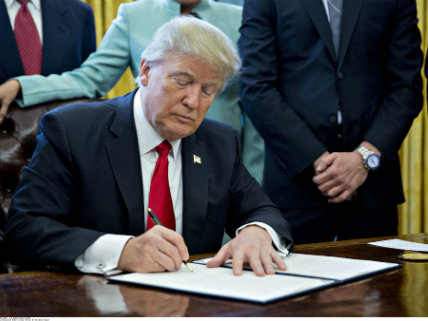Trump's Executive Order on Regulations Is Welcome, But More Is Needed
President Donald Trump followed-up a busy and divisive first week in office by issuing an executive order that takes aim at the federal regulatory state.

Surrounded by a group of business leaders on Monday morning, President Donald Trump paid off one of his campaign promises by signing an executive order telling federal agencies under the president's control to cut two federal regulations for every new rule added to the books.
"If there's a new regulation, they have to knock out two. But it goes far beyond that, we're cutting regulations massively for small business and for large business," Trump said.
Unlike previous attempts to impose similar constraints on federal regulations—like the "one in, one out" proposal from Sen. Mark Warner (D-Virginia) in 2010, which would have required agencies to offset the cost of new regulations by deleting older ones—Trump's executive order does not specify that the regulations deleted must match or exceed the economic impact of those being added.
Overall, though, the executive order specifies that new regulations issued by the federal government in 2017 "shall be no greater than zero."
An emphasis on regulatory reform from the new administration is a welcome development indeed. After another record-breaking year that added more than 90,000 pages to the federal register—if you printed them all out and stacked them up, the pages of the registry would be taller than a brontosaurus—there's no doubt that the federal regulatory state is out of control.
Still, rolling back federal regulations in a meaningful way will require more than this order.
"Regulations have compounded for decades with very little rollback ever taking place, so President Trump's executive order requiring agencies to identify two regulations for elimination, for every one new regulation issued, is both reasonable and a step in the right direction," says Clyde Wayne Crews, vice president for policy at the Competitive Enterprise Institute, a free market think tank based in Washington, D.C. "However, it is important to focus on eliminating the equivalent regulatory burden rather than a specific number of regulations."
Last year, for example, Congress passed 211 bills while federal regulatory agencies approved 3,852 regulations, according to CEI, which tracks federal regulations. Including last year's record-breaker, 13 of the 15 longest registers in American history have been authored by the past two presidential administrations (Barack Obama owns seven of the top eight, with George W. Bush filling in most of the rest), according to CEI.
Crews says the only way Trump can ensure long-lasting regulatory reform is to work with Congress. Otherwise, the next president could simply undo any executive orders he signs.
Trump seems to have some congressional support in that aim—as long as he doens't squander his political capital on other issues.
In an op-ed published last week in The Wall Street Journal, House Majority Leader Kevin McCarthy (R-California) outlined a series of regulatory reforms that take aim at the federal bureaucracy. The first step, McCarthy says, is passage of the REINS Act, which would require any new regulations that cost $100 million or more to be approved by Congress before taking effect.
As I wrote earlier this month, the REINS Act would apply only to about 3 percent of all federal regulations, but it would be a meaningful reform because it gives Congress a way to check executive rules with the potential to be particularly harmful.
In other ways, Trump's order isn't as clear-cut as the "one in, two out" phasing might suggest.
According to the order, there are several parts of the government exempted from the new guideline, including anything having to do with "military, national security, or foreign affairs function of the United States." Other exemptions include internal regulations dealing with a federal agency's organization and management. Independent agencies like the Consumer Financial Protection Bureau and the Securities and Exchange Commission, which have implemented many of the regulations created as part of the Dodd-Frank Act, passed in the wake of the 2008 economic collapse and often criticized by Trump and others for handcuffing the financial sector of the economy, will also be untouched.
There's other potential problems with Trump's order too. As Franklin Harris pointed out on Twitter, giving federal agencies responsibility over what regulations get cut creates potentially bad incentives. Rather than cutting regulations that serve no purpose, agencies would have an incentive to scrap key regulations that create an argument for keeping those rules.
It's similar to what happens during government shutdowns, when pretty much everything keeps humming along except for national parks—as a way to make a public relations point.
Maybe that will happen here and maybe it won't—hopefully the White House would exercise the power granted by the executive order allowing its Office of Management and Budget to review which regulations will be scrapped.
Either way, if regulatory reform is going to stick, it will require more than just Trump's pen.


Show Comments (78)